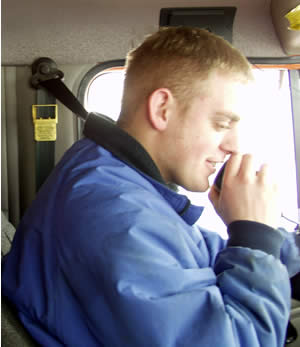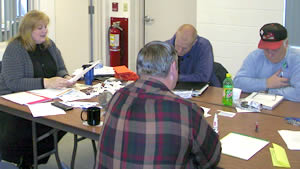 |
Joel Risser, a snowplow operator at the Dresbach
Truck Station, prepares to plow the shoulders of I-90
from Dresbach to St. Charles. Photo by Paul Ryan,
Houston County News
|
Television and newspaper reporters in Greater Minnesota recently gave their
readers a sense of the everyday reality of working as a Mn/DOT snowplow operator.
Reporters based in Rochester, LaCrescent, Houston, Alexandria, Isle, Fergus
Falls and other cities rode with plow operators as they cleared highways following
recent storms. Their accounts detail the drama and the tedium as well as the
sights, sounds and even the smells involved in snowplowing operations.
Mille Lacs Messenger reporter Diane Gibas accompanied Bryan Karels from
the Brainerd/District 3 truck station at Isle as he plowed highways 25, 65 and
47 following a January storm.
"In addition to driving the truck, the driver watches oncoming traffic,"
she wrote. "One motorist veered toward the plow, missing it by mere inches.
He keeps tabs on the vehicles behind the truck. He looks for debris in the roadway
that could be hazardous and he operates three blades on the truck—the front
plow, the wing and a scraping blade underneath the plow while he distributes
the sand/salt mixture.
"The trucks have strobe lights that make them more visible to motorists,
but when winds blow through the countryside or create eddies of snow over the
highway, it’s sometimes hard for the plow drivers to see cars," she wrote.
Quoting Karels, Gibas wrote, "When it’s a dry snow, you can smell the
plow. The plow scrapes the pavement where the snow has blown off the road. The
bare pavement is hard on the carbide plow edges."
Houston County News reporter Paul Ryan joined Paul Risser, a snowplow
operator at the Dresbach Truck Station at 2 a.m. on Feb. 2 as Risser munched
on cheese and cracker snacks during his break period. They were soon headed
down I-90 as Risser plowed the freeway’s shoulders from Dresbach to St. Charles.
Ryan observed some of the discomforts of the job—from the high cabin heat needed
to keep the windows from freezing shut to drivers flying by at high speeds in
the next lane.
Risser’s plow was struck by a car in January, the first crash he’s had.
"Luckily, the driver was okay and Risser hardly felt a bump because of
the plow’s immense size," Ryan wrote, "but accidents like these happen
all the time.
"Snowplow drivers take pride in being safe and it shows in Risser’s driving,"
he wrote. "During his route, Risser was watching approaching traffic in
the side mirror as much as he was looking out the windshield."
 |
A group of snowplow operators receives media relations training at
Detroit Lakes from Judy Jacobs, district public affairs coordinator.
Photo by Bill Hanson
|
Celeste Beam, a reporter for the Echo Press in Alexandria, rode along
with Nolan Kloehn from the Alexandria Truck Station during an early morning
sortie along Hwy 27 and Hwy 29 and I-94.
Beam described the complexity of controls in the snowplow’s cab and Kloehn’s
mastery of them.
"He was calm yet cautious, checking out the mirrors jutting from each
side of his snowplow. His head was in a constant back and forth motion—almost
as if he were watching a tennis match," she wrote.
"While I was sitting in the plow, I realized how much responsibility snowplow
drivers have when they get behind the wheel," she wrote. "They have
to pay attention to other motorists, signs along the road, the position of the
snowplow blades, road conditions, whether or not they need to apply sand and
salt and much more."
Kloehn said the ride-along went well, noting positive reactions he’s received
and the fact that the reporter included driving safety tips with his story.
One of Kloehn’s coworkers, Fergus Falls’ Tim Eide, shared his experiences clearing
I-94 and Hwy 59 in December with Joel Hagen, a Fergus Falls Daily Journal
reporter.
As they sat in the cab replete with hydraulic controls, switches, gauges and
thermometers that measure air and pavement temperatures, Eide told Hagen the
biggest changes have come in the equipment he uses.
Eide, who’s been snowplowing for 30 years, told Hagen he can usually make it
around his route in about one hour, but on an icy night it can take as much
as four or five hours.
"When it’s icy for cars, it’s icy for us," Eide said.
Both Kloehn and Eide received media relations training provided by the district
to help them work more effectively with reporters.
Recalling his experience, Karels said he was happy to have reporter Gibas ride
with him.
"It was good for the public to find out about what we do—especially when
it’s someone else’s opinion, not ours," he said. "A number of people
have mentioned the article to me since it was published. It’s been a very positive
experience."
By Craig Wilkins
|



